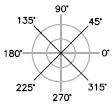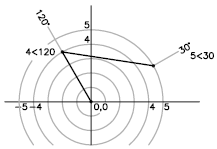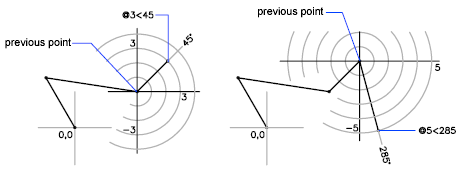You can use absolute or relative polar coordinates (distance and angle) to locate points when creating objects.
To use polar coordinates to specify a point, enter a distance and an angle separated by an angle bracket (<).
By default, angles increase in the counterclockwise direction and decrease in the clockwise direction. To specify a clockwise direction, enter a negative value for the angle. For example, entering 1<315 locates the same point as entering 1<-45. You can change the angle conventions for the current drawing with UNITS.

Absolute polar coordinates are measured from the UCS origin (0,0), which is the intersection of the X and Y axes. Use absolute polar coordinates when you know the precise distance and angle coordinates of the point.
With Dynamic Input, you can specify absolute coordinates with the # prefix. If you enter coordinates on the command line instead of in the tooltip, the # prefix is not used. For example, entering #3<45 specifies a point 3 units from the origin at an angle of 45 degrees from the X axis. For more information about Dynamic Input, see Use Dynamic Input.
The following example shows two lines drawn with absolute polar coordinates using the default angle direction setting. Enter the following in the tooltip:
Command: line
From point: #0,0
To point: #4<120
To point: #5<30

Relative coordinates are based on the last point entered. Use relative coordinates when you know the location of a point in relation to the previous point.
To specify relative coordinates, precede the coordinate values with an @ sign. For example, entering @1<45 specifies a point at a distance of 1 unit from the last point specified at an angle of 45 degrees from the X axis.
The following example shows two lines drawn with relative polar coordinates. In each illustration, the line begins at the location labeled as the previous point.
Command: line
From point: @3<45
To point: @5<285
